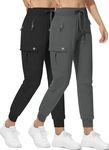Buying Guide for the Best Ski Pants For Women Petite
When it comes to picking the right ski pants for women, especially for those with a petite frame, it's important to consider several key specifications to ensure comfort, functionality, and style. Ski pants are essential for keeping you warm, dry, and mobile on the slopes. Understanding the different features and how they align with your needs will help you make the best choice.FitFit is crucial for ski pants, especially for petite women. A good fit ensures that the pants are comfortable and do not restrict movement. Ski pants come in various fits such as slim, regular, and relaxed. Slim fit is more form-fitting and stylish, ideal for those who prefer a sleek look. Regular fit offers a balance between comfort and style, suitable for most body types. Relaxed fit provides more room and is great for layering. For petite women, it's important to look for pants specifically labeled as 'petite' to ensure the length and proportions are suitable.
InsulationInsulation in ski pants is what keeps you warm in cold conditions. There are two main types: insulated and shell. Insulated pants have built-in insulation, which is great for very cold conditions. Shell pants, on the other hand, have no insulation and are more versatile, allowing you to layer underneath according to the weather. If you tend to get cold easily, opt for insulated pants. If you prefer flexibility and plan to ski in varying temperatures, shell pants with layering options might be better.
WaterproofingWaterproofing is essential to keep you dry while skiing. Ski pants come with different levels of waterproof ratings, usually measured in millimeters (mm). Ratings range from 5,000mm to 20,000mm or more. For light snow and occasional skiing, 5,000mm to 10,000mm is sufficient. For heavy snow and wet conditions, look for 15,000mm or higher. Consider your skiing environment and choose the waterproof rating that matches the typical weather conditions you will encounter.
BreathabilityBreathability is the ability of the fabric to allow moisture from sweat to escape, keeping you dry and comfortable. This is measured in grams (g) and typically ranges from 5,000g to 20,000g. Higher breathability is important if you are an active skier who tends to sweat a lot. For less intense skiing or colder conditions where sweating is minimal, lower breathability ratings are acceptable. Choose based on your activity level and how much you tend to sweat.
FeaturesAdditional features can enhance the functionality of ski pants. Look for features like reinforced cuffs to prevent wear and tear from ski edges, adjustable waistbands for a better fit, and ventilation zippers for extra breathability. Pockets are also important for carrying essentials like lift passes and snacks. Consider which features are most important to you based on your skiing habits and personal preferences.
MaterialThe material of ski pants affects their durability, comfort, and performance. Common materials include nylon and polyester, often with a waterproof and breathable membrane like Gore-Tex. Nylon is known for its durability and abrasion resistance, while polyester is lightweight and quick-drying. Choose a material that balances durability and comfort, and consider any additional coatings or treatments that enhance waterproofing and breathability.





















